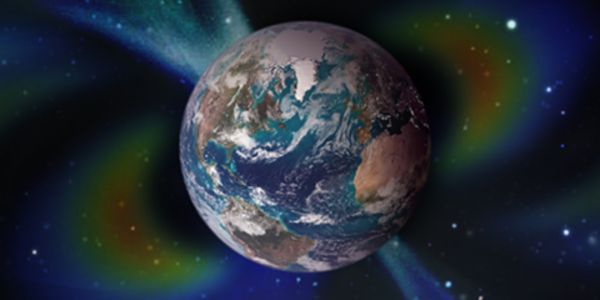
People have used Earth’s magnetic field for navigation since ancient times. Magnetic navigation has continued to improve alongside transportation technologies so that we now use magnetic models in planes, ships, vehicles, and even in smartphones. To improve magnetic navigation, NCEI scientists have tracked the changing magnetic field using satellites. This provides the most accurate and reliable models so that users can navigate their world with ease and precision. Using that work, NCEI scientists have produced both the World Magnetic Model and the Enhanced Magnetic Model.
World Magnetic Model
The World Magnetic Model or WMM is a spherical harmonic model of the magnetic field produced by Earth’s core. Its large-scale representation of the planet’s magnetic field gives analog and digital magnetic compasses dependable accuracy. And, smartphone apps use it extensively to accurately let users know which way they are going.
Developed jointly by NCEI and the British Geological Survey, the World Magnetic Model continues to be the navigation standard model for the U.S. Department of Defense, the North Atlantic Treaty Organization (NATO), International Hydrographic Organization, Federal Aviation Administration, consumer electronic companies, and many others.
Enhanced Magnetic Model
Like the WMM, the Enhanced Magnetic Model or EMM is a large-scale representation of Earth's magnetic field that gives analog and digital magnetic compasses dependable accuracy. However, the EMM has a much higher resolution than its World Magnetic Model “cousin,” requiring more computing power to run. The EMM's higher resolution results in significantly improved pointing accuracy for applications that utilize it, such as magnetic field-aided navigation. The EMM also aids scientific researchers in their study of magnetic field anomalies originating from Earth's crust, which provides insight into plate tectonics.
Predicting Changes in Earth’s Magnetic Field
Using years of satellite, marine, aeromagnetic, and ground magnetic survey data, our scientists are able to model Earth's changing magnetic field and predict what it will look like over the next five years. Produced every five years, these two models of the magnetic field generated by Earth's rapidly spinning metallic core and magnetized rocks within the lithosphere provide the best source of data for evaluating the evolution of the planet’s main magnetic field and the most accurate models for a myriad of navigational uses across the globe.
Developing Online Tools for You
In addition to creating accurate magnetic models, NCEI provides multiple online tools to estimate current and past values of the magnetic field.
-
Declination Calculator: Magnetic declination (the angle between magnetic north and true North) for a single location any time between 1590 and the present.
-
Magnetic Field Calculator: All seven magnetic field components (X, Y, Z, H, D, I, and F) for a single location on a single day to a range of multiple years from 1590 to the present.
-
Magnetic Field Properties Grid Calculator: Estimated values of Earth's magnetic field, including magnetic declination (D), based on the current WMM or the International Geomagnetic Reference Field (IGRF) for a grid of locations over a single day to multiple years.
-
U.S. Historic Declination Calculator: For the conterminous United States from 1750 to the present. It uses a combination of a historic polynomial model and the IGRF spherical harmonic models.
Each year, a wide variety of users make approximately 90,000 queries into the status of Earth’s past and present magnetic field with these online calculators. People around the world have used these data to set flight and ship paths, survey historic property boundaries, align solar panels, help hikers correct their compasses, and further our understanding of the migrations of animals like whales, birds, and butterflies.



